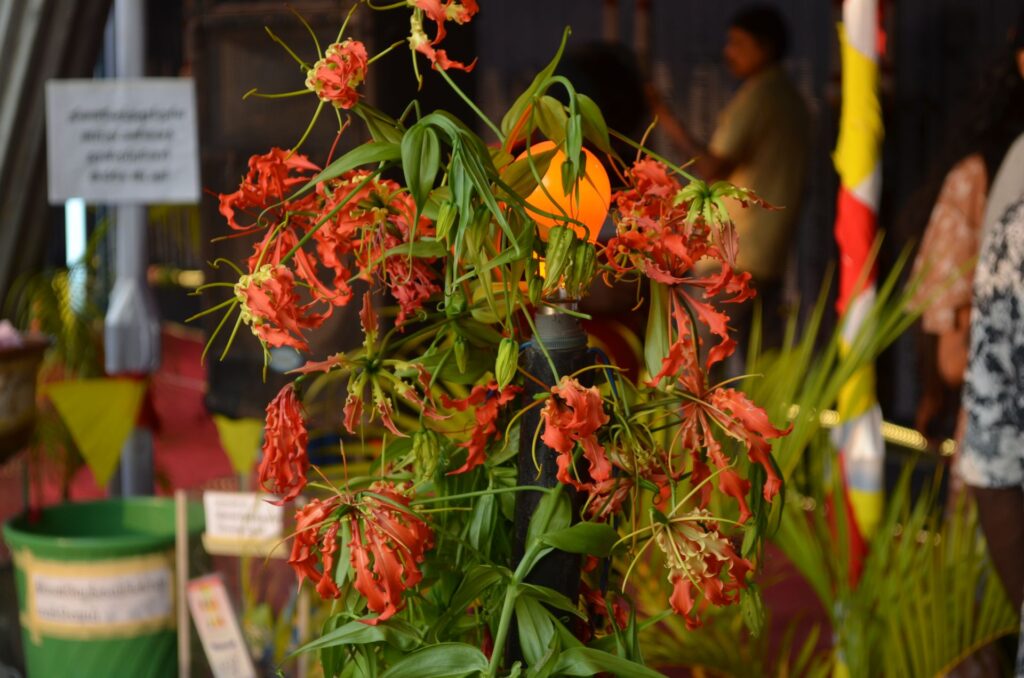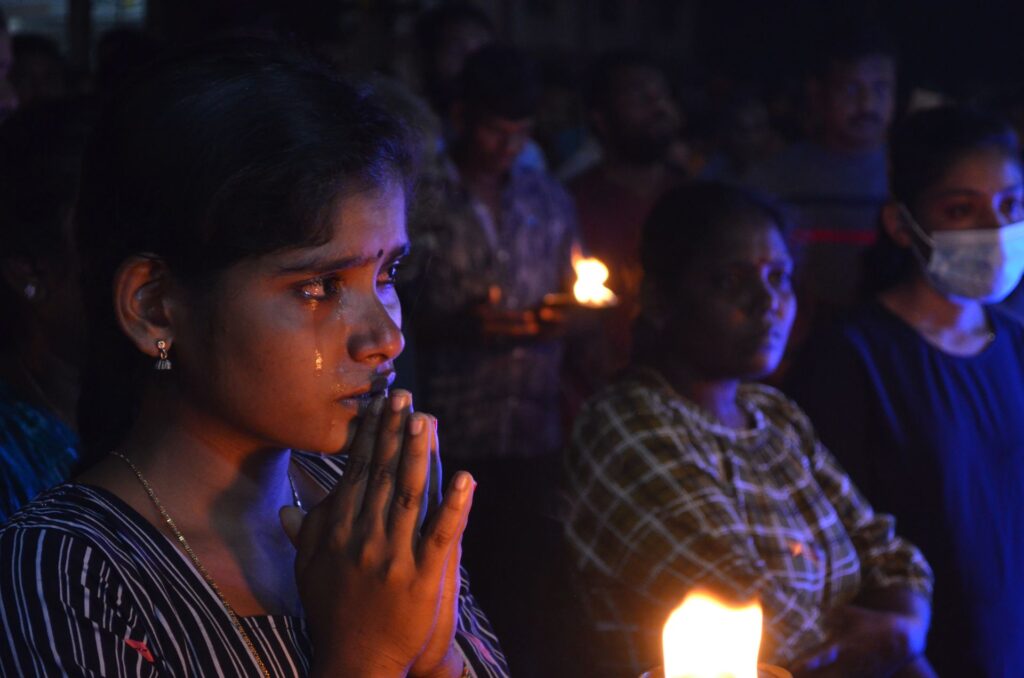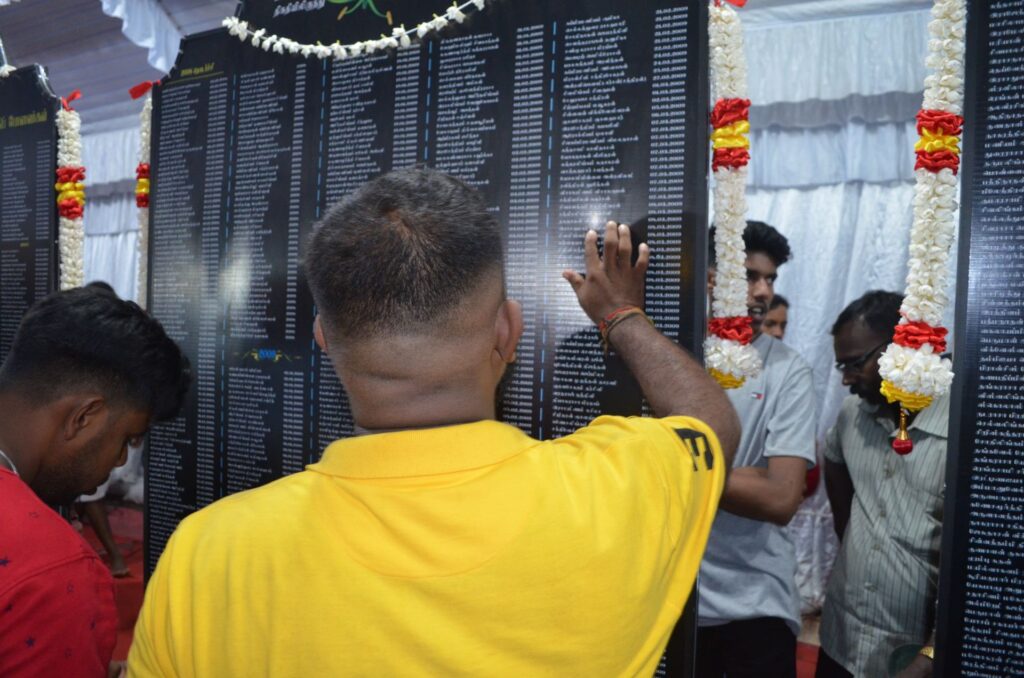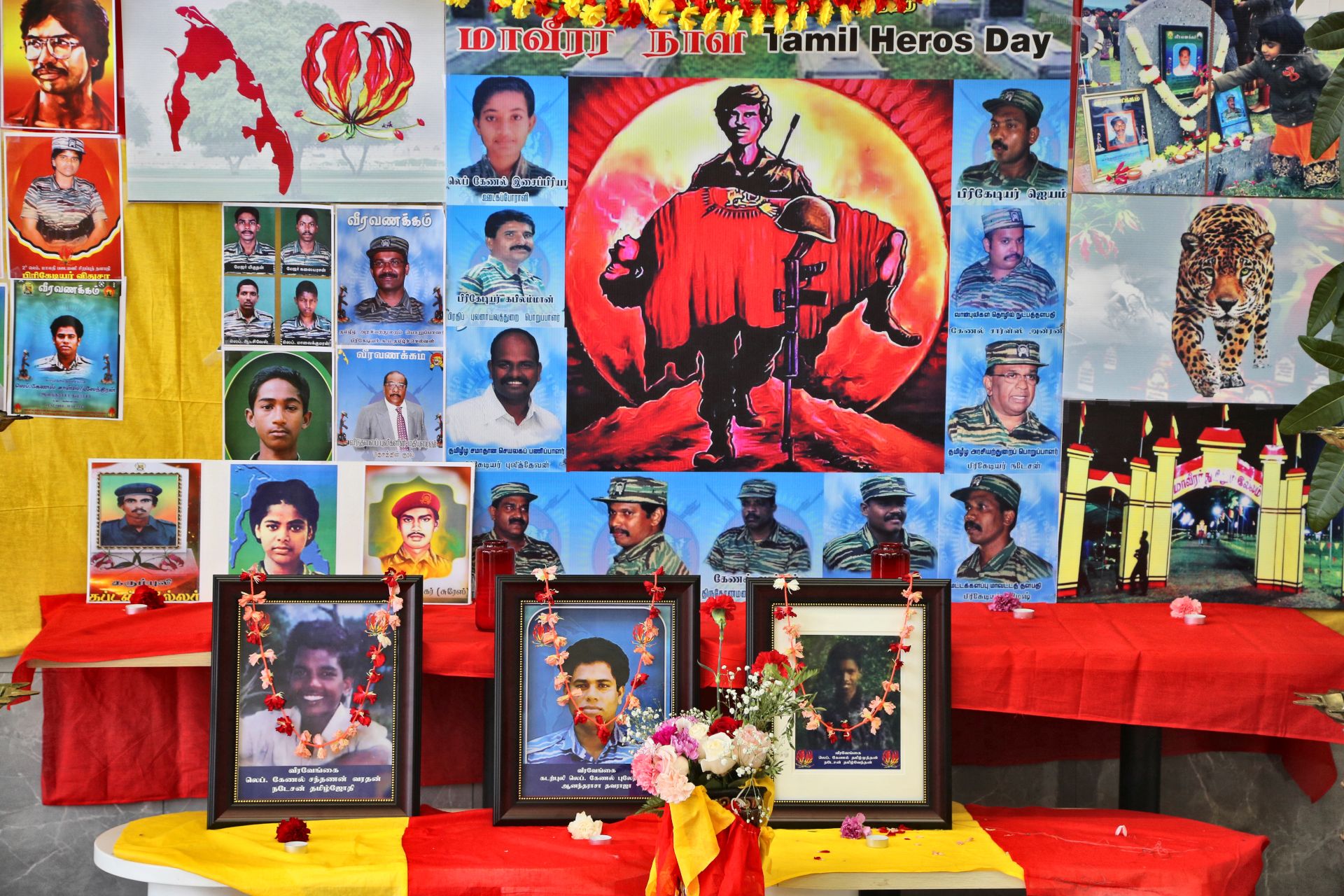Ramanthan Vijayalakshmi can reel off the date of her brother’s death by memory — Oct. 17, 1995. A 47-year-old resident of Jaffna, Sri Lanka, Vijayalakshmi had lost contact with him five years before he died, when he had been recruited as a fighter by the Liberation Tigers of Tamil Eelam, or LTTE, a militant group that had been waging a civil war against the Sri Lankan government to create a separate Tamil homeland, Tamil Eelam.
Her brother, Ramalingam Punniyamoorthy, was only in the eighth grade when he joined the militants, one of thousands of children recruited to fight during the war. “They took him away while he was still studying in school, so we didn’t know,” Vijayalakshmi says. That was in 1990. “I was so upset. He’d come home and written on the front door, ‘I’m going to join the movement, so don’t look for me.’”
Over three decades later, in November 2022, Vijayalakshmi stood in front of a long row of makeshift plaques, trying to find her brother’s name among the list of fallen LTTE cadres. There were more plaques than one could count, arranged by year and date of death, with families crowding around each one, tracing their fingers down the list, searching for the names of their relatives. For some, like Vijayalakshmi, it was a quiet moment of triumph when they found the name, while others who could not find their loved ones ended up walking away, deflated.
“When I think about him, I feel sad, I feel upset,” Vijayalakshmi says. “I’m with my children, and if my brother were alive then he’d be with us and he’d be happy too. I wouldn’t have to come and cry like this, would I?”
The story of Vijayalakshmi’s brother is just one painful memory of Sri Lanka’s brutal civil war. The conflict lasted for 26 years, concluding with a final offensive by the Sri Lankan military in 2009 that crushed the LTTE in its northern strongholds, killing tens of thousands of Tamil civilians in the process. For the Sri Lankan government, which today is focused on development and rescuing itself from a dire economic crisis, the war is considered a closed chapter. Yet the memory of those lost in the conflict, as well as those living with physical wounds and unacknowledged grief, continues to shape life on the island.
Every year, Nov. 27 is commemorated as “Maaveerar Naal,” or “Heroes Day” — a day for Tamils in Sri Lanka to remember the fallen LTTE members. The day was first celebrated in 1989 after the group’s leader, Velupillai Prabhakaran, announced that it would be an annual ritual to mark the anniversary of the death of Shankar, the first comrade to die in combat in 1982. Ever since, Maaveerar Naal has been a day for Tamils to come together in collective mourning.
The LTTE, which once ran a state within a state in Sri Lanka that boasted a capable civil administration and even a navy and air force, was eradicated at the end of the war. Yet the Maaveerar Naal commemoration has outlived the LTTE as a means of processing the pain of the conflict. Its continued commemoration offers an insight into the afterlife of one of South Asia’s deadliest modern conflicts.
There are 2.27 million Tamils living today in Sri Lanka, comprising about 11% of the population, according to a 2012 census. There are also an estimated 900,000 in the diaspora. The majority of the island’s population are Sinhalese, with a smaller population of Muslims as well. On Maaveerar Naal, Tamil resistance, crushed during the war, comes alive with patriotic songs popularized by the Tigers ringing out on speakers, their flag flying high, and the national flower of Tamil Eelam — the emblematic gloriosa lily or karthigai poo — sitting front and center at the commemorations.

Vijayalakshmi had come to Nallur, a suburb of Jaffna, the capital of Sri Lanka’s Northern Province, for the ceremonies. Local displays here are much more subdued than those in the diaspora, where people can use the LTTE’s iconography and symbols with more freedom. The Sri Lankan state continues its heavy surveillance in the Northern and Eastern provinces, where the Tamil population is concentrated. There are no LTTE flags unfurling, but there are lines upon lines of red and yellow flags — the LTTE’s colors — fluttering against the sky. A huge ceremonial fire burns on a podium, and people form a respectful queue to pay obeisance to it.
The roots of the war go back to the long troubled history between Tamils and the Sinhalese majority on the island, which boiled over into civil war in 1983. That year was marked by an episode known as “Black July,” when Sinhalese mobs lynched up to 3,000 Tamils in revenge for a militant attack that had killed 13 Sri Lankan soldiers. Over the next 26 years, the LTTE and the Sri Lankan government fought a bloody conflict that killed and displaced hundreds of thousands of civilians, with the state employing systematic sexual violence and torture as weapons of war.
Years of fighting gained the LTTE control of parts of the island’s north and east. For a time, a stalemate was maintained that returned a measure of peace to Sri Lanka, including a ceasefire lasting from 2002 to 2006. But the breakdown of peace talks that year revived the war with even greater ferocity. The conflict ended with the total defeat of the LTTE in 2009. In the final months of the war, the Sri Lankan government is accused of carrying out a genocide of Tamils in the LTTE stronghold of Mullivaikkal — a place where some estimate that as many as 170,000 civilians and others were killed.
On the day of Maaveerar Naal, Tamils across Sri Lanka’s Northern and Eastern provinces light candles to mark a minute of silence in respect for the fallen LTTE cadres. At one such ceremony, plaques listing the names of fallen fighters start with those who died in the 1980s, continuing all the way to 2009. So many names are listed for those who died in the last two years of the war that multiple plaques are needed.
In Nallur, last year, 19-year-old Murugalingam Vithursa lit a candle for her father, whom she never really got to know. He was killed in a shell attack in 2008 along with her two brothers when she was just five years old. “I feel the sadness that my father has left us,” said Vithursa, who was accompanied by her sister, aunt and sister-in-law, “and over the fact that my brothers aren’t here. That’s the sadness I’m lighting the lamp with.” She crouched down to light some incense sticks before igniting the oil lamp, and then stood in silence, tears streaking a path down her cheeks.

Yoganathan Kolasthamma, 67, lost her son Robert Roshan, who was forcibly conscripted by the LTTE during the final stages of the conflict and then killed in a shell attack in 2009. Talking about him brings tears to her eyes as she sits in a chair at the event, clutching her walker. “We feel happy but also we think of everything that our children went through,” she says, reflecting on the mixed feelings brought on by the commemoration. “How they struggled — my god, you can’t put it into words.”
Huge numbers of Tamils celebrate the LTTE as freedom fighters, lauding the decision to take up arms against a Sri Lankan state that was becoming increasingly intolerant of its Tamil and Muslim minorities. Tensions began as far back as 1956, when the government designated Sinhala as the country’s only official language. That decision provoked tensions between Sinhalese and Tamils, including a series of deadly ethnic riots. The state also rolled out an education policy in 1971 under which Tamils had to get a higher score than their Sinhalese counterparts to enter university — just one of many discriminatory measures that fed a sense that Tamils were becoming second-class citizens in the country.
The year 1981 marked a point of no return. In that year, Sinhalese mobs burned down the iconic Jaffna library after three Sinhalese police officers were killed during the rally of a Tamil political party, the Tamil United Liberation Front. Two years later, the 1983 Black July riots inaugurated the outbreak of a full-blown civil war that would define life on the island for decades and forever change the fate of Sri Lanka’s Tamil minority.
The atrocities perpetrated by the Sri Lankan government during the war are widely known and undeniable. Yet, like most ugly civil conflicts fought between ethnic groups that had once lived as neighbors, the war defies easy moral binaries. The flipside to the brutality of the government was the dark underbelly of atrocities committed by the LTTE itself, which led international governments, including the U.S., U.K. and Canada, to brand the group as a terrorist organization.
The LTTE operated a rigid framework of conscription, which intensified especially toward the end of the war, when all surviving men or women were forced to fight against the Sri Lankan state. Many children, including Vijayalakshmi’s brother, were drafted into the LTTE. The group was among the early pioneers of suicide attacks, as members were sent on missions armed with suicide vests and truck bombs tasked with hitting Sri Lankan government targets.
The LTTE also had its own troubled history with minorities and dissidents. The organization forcibly expelled Muslims from the Northern Province in 1990 in an act of ethnic cleansing, viewing them as collaborators with the Sri Lankan government. The main Muslim political party, the Sri Lanka Muslim Congress, opposed Tamil Eelam. The LTTE also allegedly massacred Muslim civilians in 1990 and killed Tamil dissidents and members of rival Tamil militant groups.
There was also a class component to the conflict that went beyond ethnicity. Many of those recruited to fight for the LTTE came from oppressed castes or underprivileged backgrounds in Tamil society. Those who were more privileged often had the means to leave the island during the war, while those who stayed behind had few options but to fight.
This is why Sharika Thiranagama, Associate Professor of Anthropology at Stanford University, says she finds it difficult to accept the glorification of the LTTE in the Tamil diaspora, where it maintains a base of support, considering they “tried to avoid the same fate for their own children.”
“Should we ask — should they have asked — those young people to fight for them? To give their lives up? Who dies for Tamil Eelam, exactly?” asks Thiranagama. Thiranagama’s own mother, Rajani, was a high-profile human rights activist in Jaffna who was assassinated by the LTTE in 1989 for documenting their atrocities.
Thiranagama believes many people turn to Maaveerar Naal because they “yearn toward a clear narrative,” which creates a black-and-white picture of the war. She argues that the nature of the commemorations allows only for the mourning of LTTE cadres who died in combat, while ignoring the thousands of Tamil civilians who were also killed by the Sri Lankan state. She believes that May 18 — the other day in the Tamil calendar designated to mourn those who died in the genocide in Mullivaikkal — would never have been permitted by the LTTE, as mourning civilians who did not join the organization was discouraged.
“Why does this have to be framed continually by an organization who never saw our lives as worth it? I would very much like to see this move into a kind of a broader understanding of Tamils and Muslims as communities who have lost a lot and who do have political violence to mourn,” Thiranagama says. “But having the LTTE version of it is almost shameful because it betrays the fact that they [the LTTE] would have never done this for them [Tamil civilians who died]. … They were about controlling mourning — the LTTE, the Sri Lankan state, they’ve always tried to control who can be mourned, in what way, how, with what colors, what flags.”
Despite these divisions and misgivings, many Tamils continue to view the LTTE’s resistance to the Sri Lankan state as heroic. The Tigers’ iconic leader, Velupillai Prabhakaran, who was killed in the last days of the war, remains a symbol of pride for many Tamils. Maaveerar Naal thus allows a space to grieve not just for those who died in the war but also for the LTTE’s aborted vision of an independent Tamil nation state. Many Tamils continue to identify themselves as Tamil nationalists, despite the demise of their independence movement. Maaveerar Naal, for them, has become not just a site of historical memory but a cornerstone of their own identity.
“It’s an act of resistance as well as an act of commemoration,” says Mario Arulthas, a Tamil academic now based in Toronto, who says that the ongoing commemorations speak to the continued appeal of the Tigers. “It’s not by accident that people choose to use the symbols and the methods and the rituals of the LTTE, despite the absence of the organization,” he adds.
While acknowledging criticisms of the group’s conduct, Arulthas also believes that the LTTE has been held to a standard not applied to wars sanctioned by the West, lamenting that Tamils are expected to apologize repeatedly for atrocities committed by the LTTE on a global stage.
“I don’t think it’s true that there is no criticism of the LTTE amongst Tamil nationalists,” Arulthas says. “But it happens in spaces and in ways that aren’t designed to play to the liberal gallery and cater to their views on violence or resistance, what is permissible violence and what isn’t, and what that means for the political ideology that is served by this violence.”
The Sri Lankan government remains suspicious of public displays that could be construed as supportive of the LTTE. This means that local commemorations of Maaveerar Naal are usually more muted in Sri Lanka itself than in the diaspora. In recent years, Tamil civilians have reported attempts by police forces to stop them from performing mourning ceremonies or displaying images allegedly tied to Tamil nationalism, as well as physical attacks against mourners. The Sri Lankan police deny such incidents. “There may be some small arguments or something like that, but generally people conducted their program leisurely in the northern and eastern area[s],” police spokesperson Nihal Thalduwa told New Lines.
However, Thalduwa did acknowledge news reports in the Tamil press during 2022 that the police had removed a memorial arch in Mullaitivu, claiming that it depicted a map of Tamil Eelam and a picture of an LTTE cadre in uniform. “Generally, police didn’t disturb them,” Thalduwa said, “but if there was anything regarding the LTTE, like photos or songs, if they break some law under the PTA, then something can happen.” The PTA refers to the Prevention of Terrorism Act, a draconian law in the Sri Lankan legal code that has been used to incarcerate Tamil political prisoners as well as other opponents of the Sri Lankan government.

In Nallur, at the commemoration service held this past November, there were surprisingly no police officers present, allowing celebrations to take place unhampered. However, a former LTTE member who spoke with New Lines, Karunagaran Sivarasa, said that he believed the lack of police presence at many of the events was a calculated move to increase surveillance of Sri Lanka’s Tamil community. The hoisting of red and yellow flags, playing LTTE songs and celebrations on a grand scale both here and in the diaspora could be used to claim that the Tigers are back, he said. “They’ll keep the armed forces here. To keep the armed forces, what do they need? They need to allocate a portion of the budget to the military. They’ve laid a trap and we’ve fallen into it.”
Sivarasa had joined the movement at the age of 19, before becoming disillusioned when the LTTE began brutally killing members of rival Tamil militant groups, such as the People’s Liberation Organization of Tamil Eelam (PLOTE) and the Eelam People’s Revolutionary Liberation Front (EPRLF). This drove him away from the LTTE and made him a vocal critic of the organization. “After 1987, they wiped out all competitors and became the leaders,” he said. “After 1990, it became a matter of: ‘It’s me and only me.’ Then it turned into slavery. … ‘I am everything. I make the judgments. What I say is law.’ At that point, you can’t say it’s a freedom fighting organization. It’s authoritarianism in the name of freedom fighting,” he said.
It is this ideology upon which Maaveerar Naal is also structured, argues the University of Jaffna academic Mahendran Thiruvarangan, adding that the day embodies a traitor-and-hero binary, which Prabhakaran had made clear in his first Maaveerar Naal speech in 1989.
During that speech, Prabhakaran had said: “If Prabhakaran also betrays Tamil Eelam, Prabhakaran must be killed. So, when we celebrate Maaveerar Naal, we must also pick out the traitors from among the people and cast them out.” In that same speech, Prabhakaran went on to outline a chilling vision for how the war must proceed toward victory, even if it meant bloodletting among Tamils themselves. “If there is war, then we must win it by killing. Even if those killings are of our own youth, we can’t show even the slightest pity,” he said. “Just like Prabhakaran isn’t a lone man as he represents the emotion of a whole race — just like that we cannot avoid killing the youth from other movements as a matter of well-being for our race. And we’ll have to keep wiping them out.”
Prabhakaran’s speeches were an annual tradition, delivered to Tamils in Sri Lanka and the diaspora even when he was in hiding. The former LTTE leader continues to hold a special significance for Tamils even after his death and is widely referred to as “Thalaivar,” which means a “leader” in Tamil. A personality cult created around him was a key part of the LTTE’s identity, and his portrait occupies a central place at Maaveerar Naal celebrations.
“The LTTE also constructed the Maaveerar [‘hero’] identity partly in opposition to this notion called traitor,” Thiruvarangan said. He explained that a traitor could be one who disagreed with the LTTE, criticized its excesses or even suggested that there could be a way besides armed militancy to win freedom from the government. “Such people were massacred and branded as traitors. So without questioning this Maaveerar [‘hero’] versus traitor binary, I think it’s difficult for one to support or participate in this event,” he concluded.
The notion of Tamil Eelam still has a stronghold on the Tamil community around the world. In February, coinciding with Sri Lanka’s 75th anniversary of independence from British colonial rule, students from the University of Jaffna organized a march from Jaffna to Batticaloa in the east, raising the slogan “End the Occupation.” While the state organized lavish celebrations in Colombo, Tamils in Mannar held a black flag protest. For Tamils, Maaveerar Naal remains the most potent day to celebrate the lost dream of Tamil Eelam.
“The attempts by the state to condemn and block Maaveerar Naal need to be condemned, but at the same time, the critique of Tamil nationalism and how that nationalist project is taken forward through [this] day is also something I’m concerned about,” Thiruvarangan says. “Coupling it with that nationalist narrative is something that I feel very uncomfortable with.”
While some Tamils at the Nallur event expressed sympathy with the idea of an independent Tamil state, Vithursa’s aunt was insistent in her support of a narrative being widely encouraged by the Sri Lankan state today — that of a pan-Sri Lankan identity that ignores ethnic and linguistic barriers. “Everyone has to be happy and united. Sinhalese, Muslims — everyone should be happy — all races. We don’t want Tamil Eelam; people should be happy,” she says.
Other critics say that dreams of nationalist revival are distracting from focus on the day-to-day challenges. Many Tamils continue to bear not just psychological but physical wounds from the conflict, including life-altering injuries that have made it impossible to find work.
“Today, Maaveerar Naal is being celebrated everywhere from the diaspora to here in Sri Lanka,” said Karunagaran, the disillusioned former LTTE militant. “But are the people who are celebrating it doing anything to provide for the basic necessities of the people who are still living, from ex-cadres to war-affected civilians?”

As the conflict itself fades further into the past, some say that the LTTE and its vision of Tamil Eelam risk becoming idealized in memory.
“When you don’t have to live with an active, violent force, it allows [the LTTE] to become something other than they were. It becomes a dream,” said Thiranagama, the Stanford professor, about how the LTTE is perceived now. “And it comes to Sri Lanka in the midst of enormous pain, because things are not changing in the way people would have wanted. There are so many intractable problems, and that’s what we should all — in Sri Lanka, in the diaspora — be focusing on. But focusing on them through the LTTE is in fact a profound betrayal. It places the LTTE at the center, not the people who really matter.”
In his last Maaveerar Naal speech in 2008, just six months before he was killed in the Sri Lankan government’s final offensive, Prabhakaran struck a much more mellow tone with his words as he paid tribute to his fallen fellow comrades. Prabhakaran insisted the LTTE “did not choose the path of weapons” but that “the violent terrorism of the racist Sinhalese government” had led them to begin the armed struggle. It is unclear upon what path Prabhakaran might have taken the organization, had it survived. But its final memories were bound up in violence.
A 45-year-old woman I met in Nallur, who wished to remain anonymous, said Maaveerar Naal was important for the future of the Tamil community. Her younger brother was a child soldier, having joined the movement at 14, in 1993. He died five years later. She herself was also involved with the LTTE. “When we stand here, small children come and ask who these people are and why we’re doing this,” she says. “Because we’re memorializing, people will remember that Tamil people were like this and did all this; otherwise, it’ll be forgotten.” However, two days after the event in Nallur, there is no trace of any of it. The memorial, the plaques, the flowers, the flags, the canopy — are all gone. But traces of the troubled legacy of Sri Lanka’s postwar landscape remain hidden deep in people’s homes and hearts, until next year allows them fresh expression.
Sign up to our mailing list to receive our stories in your inbox.



